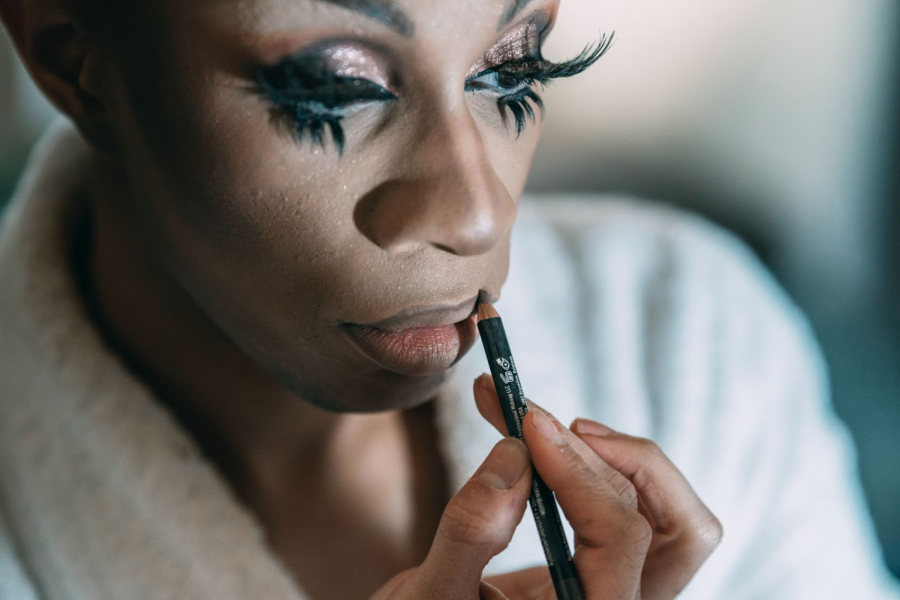Grand Junction’s Drag Debut
December 15, 2021
Recently, Grand Junction got a special visit from a group that it maybe wasn’t quite ready for: three drag queens, Bob the Drag Queen, Eureka O’Hara, and Shangela Laquifa Wadley. As a part of the HBO unscripted series, :We’re Here,” small town residents were recruited and trained to participate in a one-night only drag show performance by this renowned drag trio.
Production crews chose to film a live taping at the old Greyhound Bus Station located at the intersection of South Fifth street and Ute Avenue. This production invites local residents to attend their filming for a special chance to appear on this show’s second running season. The newest episode titled, “Serving Lewks in Grand Junction, Colorado”, specifically includes the queens empowering three transgender members of our community. These host queens go to areas where there’s not usually a robust LGBTQ+ scene to empower their “drag daughters,” as they call them, and help usher in greater acceptance in the wider community. In most episodes this includes reuniting family members, changing locals’ perceptions of drag and knocking outdated stereotypes.
This one of a kind feature is quite a big deal to this small town of ours. Drag and all its flashy glory is not exactly celebrated in Grand Junction as much as a larger city and less conservative areas. Drag may be described as ‘scary’ or appalling by an average resident, but there is a small pocket of our society that celebrates it.
With the featuring of local LGBTQ+ members and their journeys, not only is this show drawing attention to a broader audience, but it’s also uniting renowned members of the community and locals with just as respectable stories. Drag is a performance art and a means of expression for many. Its ability to excite and mesmerize altogether has been cherished for decades but also feared. In places such as Grand Junction, seeing world renowned drag queens dress up locals for television may be taken in many different ways by the public, but it certainly is an extraordinary occurrence for the valley.
When interviewed on their visit to Grand Junction, the three drag queens cohesively stated, “I felt the most glamorous in Grand Junction…the pride community here is unmatched, so rich with love and passion for their self expression. Even while small…”
The interviews displayed an appreciation for a small town, with a small LGBTQ+ community, that clearly showed its passion for performance and expression. Each member of the community picked out was given a special ‘lewk’, a term used to describe each drag queens original outfit, makeup and oftentimes, wig. This was in order to showcase their personality and passions. This really showed the intent of this show and everything it stands for.
Drag has been around for decades, but it has gained more recognition in recent years, mostly because of the surge in societal acceptance toward the LGBTQ+ community, but also because it is a driver in entertainment, and entertainment sells. Furthermore, drag now has its very own special place on television: “Rupaul’s Drag Race,” which has been airing since around early 2009.
On the show, many queens, including the three who recently visited, got their drag debut and first introduction to the world. With cultural shifts like these, we are breaking barriers that separate individuals like the three drag hosts and residents of Junction. Though some may have not appreciated their arrival or the increased acceptance of LGBTQ+ people, it is a very special time that we see things like this. And the motivation of shows like, “We’re Here,” is only centered around inspiration and general positivity, it’s to uplift and guide local LGBTQ+ members who may have been thrown to the curb.
Not only did the lucky selected residents of Grand Junction get to perform in a drag show with these renowned stars, but they got the pleasure of conversing with those who have faced some of the harshest adversity, and have overcome nonetheless. The flamboyant attitudes of these three queens are inspiring and a pure reason to keep living as your truest self, not just part of their stage acts. For members of a small community such as ours, their infectious presence was unforgettable. The big wigs and dramatic makeup looks represent yes, entertainment and laughs for those watching, but also expression and assertion of self for those performing. They are truly walking pieces of art and a symbol of pride like no other. With society adapting to the phenomenon just too powerful to push out, small towns like us should be just as open to accepting their impacts and colorful characters. Because they are the ones shedding the most positivity.

